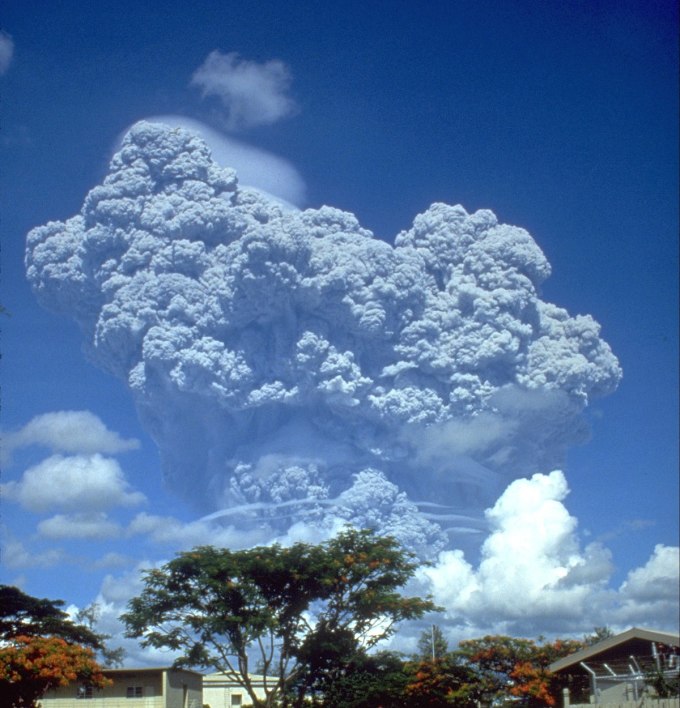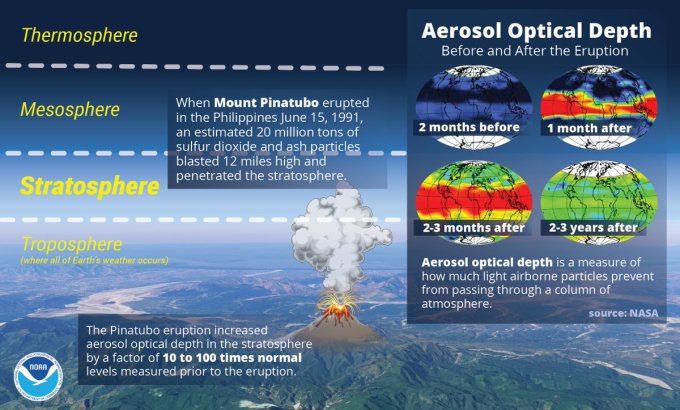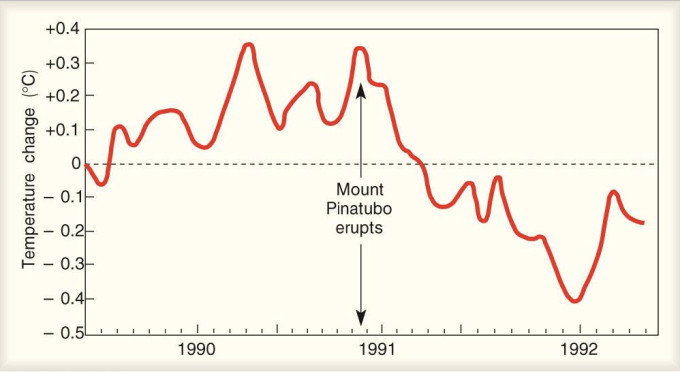Mario Picazo
Meteorologist, PhD
Monday, January 13th 2020
When a volcano the size of Taal erupts and later enters a more explosive mode, aerosols that are ejected into the atmosphere can reach altitudes of 15 to 20 kilometres.
The Taal volcano is one of a dozen large active volcanoes in the Philippines and has recently shown signs of how active it really is by spewing ash, water vapour and other gases high up into the atmosphere. The volcano is located only 60 kilometres from Manila, the country’s capital, so authorities have urged more than half a million people in the metro and surrounding areas to evacuate.
Also on the island of Luzon, and just south of where Taal is located, lies another historic volcano called Pinatubo. Back in June 1991, this volcano caused one of the most violent volcanic eruptions of the 20th century, killing hundreds and causing the global climate to change in several areas of the planet. Taal has not experienced the same explosiveness that Pinatubo had nearly three decades ago, but according to the Institute of Volcanology in the Philippines, the potential is there.
Due to this risk, scientists at the institute have been gradually increasing the alert level from 2 this weekend to now 4 out of a maximum of 5. This level is indicative of the potential for an explosive eruption to occur in the coming days, which could be similar to the Pinatubo eruption back in the 90s.
 Mount Pinatubo eruption. Credit: Wikimedia Commons
Mount Pinatubo eruption. Credit: Wikimedia Commons
Eruptions of this magnitude often send cascading rivers of lava that can engulf entire villages and present different hazards based on their geographic location. Larger explosions that occur near a water body, such as the Taal volcano, are able to release clouds of ash that can travel hundreds of kilometres per hour downslope. The toxic gases from the eruption often mix within the cloud and carry the potential for landslides in the area they travel over.
When a volcano the size of Taal erupts and later enters a more explosive mode, a large portion of the solid material (aerosols) ejected into the atmosphere can reach altitudes of 15 to 20 kilometres. Once the solid and gas material reaches those heights, it can remain suspended in the air for months as it circulates the globe pushed by prevailing upper levels winds.

We will know more about the impact Taal could end up having on climate and the environment as the eruption process unfolds. If the eruption ends up being as explosive as that of Pinatubo, aerosols in the atmosphere could block about 10 per cent of the solar radiation that typically reaches Earth. This reduction of solar radiation results in a cooling effect, which can be more intense in some regions than others, depending on factors such as atmospheric circulation during and after the actual eruption.
A scenario of higher aerosol concentrations would cause global surface temperatures to drop considerably, which would impact crops and the main ecosystems in the region. For instance, during the Pinatubo eruption, average temperatures in the northern hemisphere dropped close to 0.6°C.
 A temperature drop after the Mount Pinatubo explosion. Credit: NOAA
A temperature drop after the Mount Pinatubo explosion. Credit: NOAA
Simultaneously, temperatures in the stratosphere rose due to solar radiation absorption by the ash cloud. While levels of stratospheric ozone declined over time, sulphur dioxide that was ejected by the powerful eruption went through an oxidation process that eventually converted them into sulfuric acid droplets capable of affecting different ecosystems with acid rain.
Taal may or may not end-up fabricating a similar scenario to the one resulting from the explosions of Pinatubo or other major volcano eruptions like Krakatoa (1883), or el Chichón (1982), but time will say. In the meantime, the Philippines will need to remain alert as this region might have to adapt to a cooler temporary climate scenario if a major volcanic explosion does occur in the coming days.
The Taal volcano is one of a dozen large active volcanoes in the Philippines and has recently shown signs of how active it really is by spewing ash, water vapour and other gases high up into the atmosphere. The volcano is located only 60 kilometres from Manila, the country’s capital, so authorities have urged more than half a million people in the metro and surrounding areas to evacuate.
Also on the island of Luzon, and just south of where Taal is located, lies another historic volcano called Pinatubo. Back in June 1991, this volcano caused one of the most violent volcanic eruptions of the 20th century, killing hundreds and causing the global climate to change in several areas of the planet. Taal has not experienced the same explosiveness that Pinatubo had nearly three decades ago, but according to the Institute of Volcanology in the Philippines, the potential is there.
Due to this risk, scientists at the institute have been gradually increasing the alert level from 2 this weekend to now 4 out of a maximum of 5. This level is indicative of the potential for an explosive eruption to occur in the coming days, which could be similar to the Pinatubo eruption back in the 90s.
 Mount Pinatubo eruption. Credit: Wikimedia Commons
Mount Pinatubo eruption. Credit: Wikimedia CommonsEruptions of this magnitude often send cascading rivers of lava that can engulf entire villages and present different hazards based on their geographic location. Larger explosions that occur near a water body, such as the Taal volcano, are able to release clouds of ash that can travel hundreds of kilometres per hour downslope. The toxic gases from the eruption often mix within the cloud and carry the potential for landslides in the area they travel over.
When a volcano the size of Taal erupts and later enters a more explosive mode, a large portion of the solid material (aerosols) ejected into the atmosphere can reach altitudes of 15 to 20 kilometres. Once the solid and gas material reaches those heights, it can remain suspended in the air for months as it circulates the globe pushed by prevailing upper levels winds.

We will know more about the impact Taal could end up having on climate and the environment as the eruption process unfolds. If the eruption ends up being as explosive as that of Pinatubo, aerosols in the atmosphere could block about 10 per cent of the solar radiation that typically reaches Earth. This reduction of solar radiation results in a cooling effect, which can be more intense in some regions than others, depending on factors such as atmospheric circulation during and after the actual eruption.
A scenario of higher aerosol concentrations would cause global surface temperatures to drop considerably, which would impact crops and the main ecosystems in the region. For instance, during the Pinatubo eruption, average temperatures in the northern hemisphere dropped close to 0.6°C.
 A temperature drop after the Mount Pinatubo explosion. Credit: NOAA
A temperature drop after the Mount Pinatubo explosion. Credit: NOAASimultaneously, temperatures in the stratosphere rose due to solar radiation absorption by the ash cloud. While levels of stratospheric ozone declined over time, sulphur dioxide that was ejected by the powerful eruption went through an oxidation process that eventually converted them into sulfuric acid droplets capable of affecting different ecosystems with acid rain.
Taal may or may not end-up fabricating a similar scenario to the one resulting from the explosions of Pinatubo or other major volcano eruptions like Krakatoa (1883), or el Chichón (1982), but time will say. In the meantime, the Philippines will need to remain alert as this region might have to adapt to a cooler temporary climate scenario if a major volcanic explosion does occur in the coming days.
---30---













